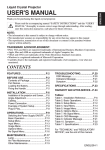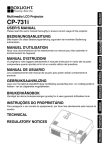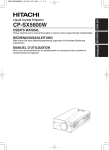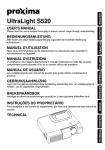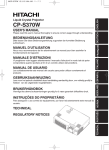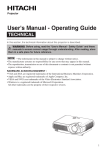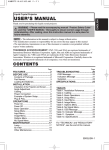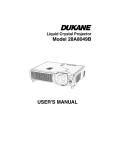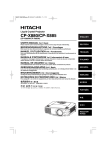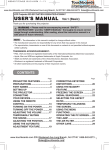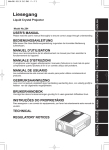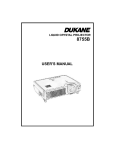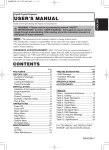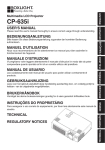Download USER`S MANUAL - About Projectors
Transcript
USER'S MANUAL Thank you for purchasing this liquid crystal projector. Please read the accompanying manual “SAFETY INSTRUCTIONS” and this “USER'S MANUAL” thoroughly to ensure correct usage through understanding. After reading, store this instruction manual in a safe place for future reference. NOTE: • The information in this manual is subject to change without notice. • The manufacturer assumes no responsibility for any errors that may appear in this manual • The reproduction, transmission or use of this document or contents is not permitted without express written authority. TRADEMARK ACKNOWLEDGMENT: • PS/2, VGA and XGA are registered trademarks of International Business Machines Corporation. • Apple, Mac and ADB are registered trademarks of Apple Computer, Inc. • VESA and SVGA are trademarks of the Video Electronics Standard Association. • Windows is a registered trademark of Microsoft Corporation. • Carefully observe the trademarks and registered trademarks of all companies, even when not mentioned. CONTENTS FEATURES ....................................P.2 TROUBLESHOOTING.................P.20 BEFORE USE ................................P.2 OSD Message...................................P.20 Indicators Message ...........................P.21 Symptom ...........................................P.22 Contents of Package...........................P.2 Part Names .........................................P.3 Loading the Battery .............................P.5 Fixing the Handle ................................P.5 SPECIFICATIONS .......................P.23 WARRANTY AND AFTER-SERVICE...P.24 INSTALLATION .............................P.6 Installation of the projector and Screen.....P.6 Angle Adjustment ................................P.6 Cabling ................................................P.7 Power Connection...............................P.8 Example of System Setup...................P.8 Plug & Play..........................................P.8 OPERATIONS................................P.9 Switching the Power Supply ON/OFF ....P.9 Basic Operation.................................P.10 Setup Menu.......................................P.12 Input Menu ........................................P.13 Image Menu ......................................P.14 Options Menu....................................P.15 No Signal Menu.................................P.16 Tables: Table 1. Installation Reference .............P.6 Table 2. Basic Operations...................P.10 Table 3. Setup Menu...........................P.12 Table 4. Input Menu ............................P.13 Table 5. Image Menu ..........................P.14 Table 6. Options Menu........................P.15 Table 7. No Signal Menu.....................P.16 Table 8. OSD Message.......................P.20 Table 9. Indicator Message.................P.21 Table 10. Symptom .............................P.22 Table 11. Specifications ......................P.23 For "TECHNICAL" and "REGULATORY NOTICE", see the end of this manual. MAINTENANCE...........................P.17 Lamp .................................................P.17 Air Filter Maintenance .......................P.19 Other Maintenance............................P.19 ENGLISH-1 ENGLISH Liquid Crystal Projector FEATURES This liquid crystal projector is used to project various computer signals as well as NTSC / PAL / SECAM video signals onto a screen. Little space is required for installation and large images can easily be realized. • Outstanding brightness The UHB lamp and high-efficiency optical system assure a high level of brightness. • Partial magnification function Interesting parts of images can be magnified for closer viewing. • Distortion correction function Distortion-free images are quickly available. BEFORE USE Contents of package Make sure all of the following items are included in the package. If anything is missing, please contact your dealer. NOTE: Keep the original packing material for future reshipment. Power Cord US Type Power Cord UK Type Power Cord Europe Type Video/Audio Cable Mouse cable (PS/2) BEDIENUNGSANLEITUNG Bitte lessen Sie diese Bedienungsanleitung zugunsten der korrekten Bedienung aufmerksam. MANUEL D'UTILISATION Nous vous recommandons de lire attentivement ce menuel pour bien assimiler le fonctionnement de l'appareil. MANUAL D'ISTRUZIONI Vi preghiamo voler leggere attentamente il manuale d'sitruzioni in modo tale da poter comprendere quanto riportato ai fini di un corretto utilizzo del proiettore. MANUAL DE USUARIO Lea cuidadosamente este manual del usuario para poder utilizar corretamente el producto. GEBRUIKSAANWIJZNG Lees voor het qebruik alstublieft deze handleiding aandachtig door, om volledig profijt te hebben van de uitgebreide mogelijkheden. BRUKERHÅNDBOK Vennligst les denne bruksanvisningen grundig for å være garantert driftssikker bruk. INSTRUÇÕES DO PROPRIETÁRIO Para assegurar o uso correto do equipamento, por favor leia atentamente este manual do usuário. TECHNICAL REGULATORY NOTICES NEDERLANDS ESPAÑOL ITALIANO FRANÇAIS DEUTSCH USER'S MANUAL NORSK 0000000000000 Please read this user's manual thoroughly to ensure correct usage through understanding. TECHNICAL PORTGÊS Liquid Crystal Projector ENGLISH Projector RGB Cable User’s Manual (this manual) Handle VIDEO STANDBY/ON RGB MENU SELECT MENU MAGNIFY POSITION RESET FREEZE VOLUME MUTE OFF AUTO TIMER BLANK Safety Instructions Remote Controller containing Battery ENGLISH-2 Carrying Bag Part Names Speaker Zoom Knob Focus Ring Handle Hook Remote Control Sensor Power Switch Lens Slide Lens Door Foot Adjuster FRONT/LEFT VIEW OF THE PROJECTOR AC Inlet (to the Power Cord) Ventilation Openings (Intake) Control Panel (Refer to P.9 "OPERATIONS") INPUT Button LAMP Indicator TEMP Indicator POWER Indicator RESET Button MENU Button STANDBY/ON Button MUTE Button Foot Adjuster Button Air Filter and Intake (for the Cooling Fan) Ventilation Openings (exhaust) Rear Foot Adjuster REAR/RIGHT VIEW OF THE PROJECTOR Terminal Panel (Refer below) S-VIDEO Terminal Remote Control Sensor VIDEO IN Terminal RGB IN 1 Terminal AUDIO IN L Terminal RGB IN 2 Terminal 1 AUDIO IN R Terminal AUDIO IN AUDIO 1 IN VIDEO IN 2 AUDIO OUT 2 RGB IN S-VIDEO IN USB RGB OUT CONTROL AUDIO IN 1 Terminal CONTROL Terminal AUDIO IN 2 Terminal RGB OUT Terminal AUDIO OUT Terminal USB Terminal TERMINAL PANEL ENGLISH-3 ENGLISH B E F O R E U S E ( c o n t i nu e d ) BEFORE USE (continued) Part Names (continued) VIDEO Button STANDBY/ON Button VIDEO STANDBY/ON RGB RGB Button MENU SELECT Button Used to click the left mouse button. Button MENU SELECT Used to operate the mouse shift function . POSITION Button MENU MENU Button MAGNIFY Button OFF RESET Button Used to click the right mouse button. Button MAGNIFY MAGNIFY POSITION RESET MAGNIFY FREEZE VOLUME Button MUTE OFF AUTO AUTO Button TIMER Button TIMER BLANK VOLUME Button VOLUME Button FREEZE Button MUTE Button BLANK Button Battery Holder REMOTE CONTROL TRANSMITTER (Refer to P.9 "OPERATIONS") : These functions works when the mouse control function is activated. Remember, the POSITION, BLANK ON and MENU ON functions disable the mouse control function. NOTE: To prevent any malfunction; • Do not give the remote control transmitter any physical impact. Take care not to drop. • Do not place the heavy objects on the remote control transmitter. • Do not wet the remote control transmitter or place it on any wet object. • Do not place the remote control transmitter close to the cooling fan of the projector. • Do not disassemble the remote control transmitter in case of malfunction. Please bring it to the service station. ENGLISH-4 Loading the Battery CAUTION Danger of explosion if battery is incorrectly replaced. Be careful in handling the battery according to instructions of the accompanying manual “SAFETY INSTRUCTIONS” and this manual. Replace only with the same or equivalent type recommended by the manufacturer. Use the 3V micro lithium battery type no. CR2025 only. When you dispose the battery, you must obey the law in the relative area or country. Keep the battery away from children and pets. First Loading: In original packing, the battery is installed in the battery holder of the remote controller with protection film(the transparent filmsome of which is inside the battery folder). Pull out the protection film to load the battery. “+” side Replacing: 1. See the reverse side of the remote controller. 2. Pinch the groove and pull out battery holder as the drawing right. 3. Remove the worn battery. 4. Install the new battery with “+” side facing. 5. Push in and click the battery holder. Pull out Battery Holder Fixing the Handle Fix the enclosed handle if you need. 1. Raise up the handle hook, and pass one end of the handle through the hole of handle hook. 2. Buckle the end of the handle, as the right drawing. 3. Fix the other end of the handle to the other handle hook in the same way. 1 2 CAUTION Make sure the handle is fixed before carrying the projector with the handle. If the projector should be dropped from the handle should be off, it could result in an injury, and continued use could result in fire or electrical shock. Do not flourish the projector with the handle. ENGLISH-5 ENGLISH B E F O R E U S E ( c o n t i nu e d ) INSTALLATION Installation of the Projector and Screen Refer to the drawing and table below for determining of the screen size and projection distance. a: Distance from the LCD projector to the screen. The projection distances shown in the table below are for full size (800 x 600 dots). Table 1. Installation Reference TOP VIEW a a (inches) Screen size (inches) Min. 40 65 78 60 98 117 Max. 80 131 157 100 163 196 120 196 236 150 246 295 200 328 394 SIDE VIEW CAUTION • Install the projector in a suitable environment according to instructions of the accompanying manual “SAFETY INSTRUCTIONS” and this manual. • Please basically use liquid crystal projector at the horizontal position. If you use liquid crystal projector by the lens up position, the lens down position and the side up position, this may cause the heat inside to build up and become the cause of damage. Be especially careful not to install it with ventilation holes blocked. Angle Adjustment Use the foot adjuster on the bottom of the projector to adjust the projection angle. It is variable within 0˚ to 9˚ approximately. Foot Adjuster Press the foot adjuster button Rear Foot Adjuster 1. Lift up the front side of the projector, and pressing the foot adjuster button, adjust the projection angle. 2. Release the button to lock at the angle to be fixed. 3. Turn the rear foot adjuster to adjust the left-right slope. CAUTION Do not release the foot adjuster button unless the projector is being held; otherwise, the projector could overturn or the fingers could get caught and cause personal injury. ENGLISH-6 Cabling RGB signal input: Connect the RGB IN 1 or 2 terminal of the projector to the RGB signal output of the computer by the enclosed RGB cable. For some modes, the optional Mac adapter is necessary. Consult your dealer to connect with the Apple computer. Some computers may have multiple display screen modes. Use of some of these modes will not be possible with this projector. Audio signal input (from computer) : Connect the AUDIO IN 1 or 2 terminal of the projector to the audio signal output of the computer by the optional audio cable. Video signal input: Connect the VIDEO IN terminal of the projector to the video signal output of the video tape recorder by the enclosed video/audio cable except for S-Video signal. For S-Video signal, use the S-VIDEO IN terminal of the projector and the optional S-Video cable with Mini DIN 4-pin jack. Audio signal input (from video tape recorder) : Connect the AUDIO IN R and L terminals of the projector to the audio output of the video tape recorder by the enclosed video/audio cable with RCA jack. RGB signal output: Connect the RGB OUT terminal of the projector to the RGB signal input terminal of the monitor by the optional RGB cable with D-sub 15-pin shrink jack and inch thread screws. Audio signal output: Connect the AUDIO OUT terminal of the projector to the audio signal input terminal of the speaker by the optional audio cable with stereo mini jack. PS/2, ADB , Serial or RS-232C communication: Connect the CONTROL terminal of the projector to the computer by an appropriate cable. For PS/2 mouse control (for IBM and compatible) use the enclosed mouse cable. For others, consult your dealer. USB communication (mouse control only): Connect the USB jack (B type) of the projector to the USB jack (A type) of the computer by optional USB cable. CAUTION • Incorrect connecting could result in fire or electrical shock. Please read this manual and the separate “SAFETY INSTRUCTIONS”. • Before connecting, turn off to all devices to be connected, except for the USB cable. • The cables (Power cord, RGB cable and other cables) may have to be used with the core set to the projector side. Use the cables which are included with the projector or specified. Core NOTE: • Before connecting, read the instruction manuals of the devices to be connected, and make sure that the projector is compatible with the device. • Secure the screws on the D-sub connectors and tighten. • Refer to the TECHNICAL section for the pin assign of connectors and RS-232C communication data. ENGLISH-7 ENGLISH INSTALLATION (continued) INSTALLATION (continued) Power Connection Use the correct one of the enclosed power cords depending on the power outlet to be used. Connect the AC inlet of the projector to the power outlet firmly by the power cord. WARNING Power outlet • Be carful in handling the power cord according to instructions of the accompanying manual "SAFETY INSTRUCTIONS" and this manual. • Connect the power cord firmly. Avoid using a loose, unsound outlet or contact failure. Power Cord AC Inlet Example of system setup Video tape recorder with S jack Video tape recorder Computer (notebook type) 1 AUDIO IN AUDIO 1 IN VIDEO IN 2 AUDIO OUT RGB IN RGB Cable 2 S-VIDEO IN USB RGB OUT CONTROL RS-232C Cable Computer (desktop type) Speaker (with built-in amp) Display monitor NOTE: When connecting with notebook computer, set to valid the RGB external image output (setting CRT display or simultaneous display of LCD and CRT). Please read instruction manual of the notebook for more information. Plug & Play This projector is VESA DDC 1/2B compatible. Plug & play is possible by connecting to a computer that is VESA DDC (Display Data Channel) compatible. (Plug & play is a system configured with peripheral equipment including a computer and display, and an operating system. NOTE: • Use the RGB cable included with this projector when using plug & play. With other cables, pins (12), (15) are sometimes not connected. • Plug & play is available only when the RGB cable is connected to the RGB IN 1 terminal. ENGLISH-8 Switching the Power Supply ON/OFF Switching Power ON 1. Check that the power cord is connected correctly. 2. Set the power switch to [ | ]. The standby mode is selected, and the Power indicator is turned to orange. 3. Press the STANDBY/ON button on the control panel or the remote control transmitter. Warm-up begins and the Power indicator blinks in green. 4. The Power indicator ceases blinking and turns to green when power is on. Open the slide lens door. 5. Adjust picture size using the projection lens Zoom Knob. 6. Adjust focus using the projection lens Focus Ring. STANDBY/ON Button POWER Indicator STANDBY/ ON Button VIDEO STANDBY/ON RGB MENU SELECT MENU POSITION RESET Zoom Knob MAGNIFY FREEZE VOLUME Focus Ring MUTE OFF AUTO Power Switch TIMER BLANK Slide Lens Door Switching Power OFF 1. Press the STANDBY/ON button on the control panel or the remote control transmitter for approximately two second. The projector lamp is extinguished and lamp cooling begins. The Power indicator blinks orange during lamp cooling. Pressing the STANDBY/ON button has no effect while the Power indicator is blinking. 2. The system assumes the Standby mode when cooling is complete, and the Power indicator ceases blinking and changes to orange. Check that the indicator is orange and set the Power switch to [O]. 3. The Power indicator is extinguished when power is off. Do not forget to close the lens door. WARNING Please read this manual, and the separate “SAFETY INSTRUCTIONS” thoroughly before using the equipment. Always ensure that the equipment is used safely. NOTE: • Except in emergencies, do not turn off unless the Power indicator is orange as it will reduce the life of the projector lamp. • To prevent any troble, turn on/off the projector when the computer or video tape recorder is OFF. Providing a RS-232C cable is connected, turn on the computer before the projector. ENGLISH-9 ENGLISH OPERATIONS OPERATIONS (continued) Basic Operation The Basic operations shown in Table 2 is performed from the projector control panel or the supplied remote control transmitter. (items indicated by * may be used from the control panel) NOTE: Use the remote control transmitter at a distance of approximately 3m from the sensor on the front of the projector, and within a range of 30° left-right. Strong light and obstacles will interfere with operation of the remote control transmitter. Table 2 . Basic Operation Item Description Changes in input signal in sequence: Press INPUT button.* RGB1 → RGB2 → VIDEO → S-VIDEO (→ RGB1) Select RGB input: Press RGB button. INPUT SELECT VIDEO/S-VIDEO → RGB1/RGB2 RGB2 ↔ RGB1 Select VIDEO/S-VIDEO input: Press VIDEO button. RGB1/RGB2 → VIDEO/S-VIDEO S-VIDEO ↔ VIDEO • The selected signal name is displayed for approximately three seconds when the input signal is changed. POSITION Set/Clear position adjustment mode: Press POSITION button. The [ ] icon is displayed in the POSITION mode. Image position adjustment: Press the , , and buttons in the position adjustment mode. • Valid only in the MAGNIFY mode with VIDEO/S-VIDEO input. • The [ ] icon is extinguished, and the position adjustment mode cleared automatically, after approximately ten seconds of inactivity. , , and buttons may operate as the mouse control button. Refer to P.4. RESET * Initialise menu items: Select an item and press the RESET button. Initialise position adjustment: Press the RESET button and the POSITION mode.Valid only when RGB signal is input. • Valid except for VOLUME, LANGUAGE and H PHASE. • RESET button may operate as the mouse control button. Refer to P.4. MAGNIFY Set MAGNIFY mode: Press the MAGNIFY button. Move magnified area: Run Position Adjustment in MAGNIFY mode. Adjust magnification: Press MAGNIFY / in MAGNIFY mode. Clear MAGNIFY mode: Press MAGNIFY button. • MAGNIFY is cleared by running or setting AUTO, ASPECT, INPUT SELECT or VIDEO, or by changing the input signal. OFF FREEZE ENGLISH-10 Set/Clear FREEZE mode: Press FREEZE button. The [II] icon is displayed, and the image frozen, in the FREEZE mode. • FREEZE is cleared by running or setting POSITION, VOLUME, MUTE, Auto Adjust, BLANK ON/OFF, or MENU ON/OFF, or by changing the input signal. • Do not forget to clear frozen static images. Table 2. Basic Operation (continued) Item Description VOLUME Volume adjustment : Reduce VOLUME ↔ Increase VOLUME MUTE * Set/Clear Mute mode: Press the MUTE No sound is heard in the MUTE mode. button. AUTO TIMER ON/OFF Automatic adjustment at RGB input: Press the AUTO button. Horizontal position(H.POSIT), vertical position (V.POSIT),clock phase (H.PHASE), and horizontal size(H.SIZE) are automatically adjusted. Use with the window at maximum size in the application display. Automatic adjustment at VIDEO/S-VIDEO input: Press the AUTO button. A signal type appropriate for the input signal is selected automatically. Valid only when AUTO is set for VIDEO on the menu. • This operation requires approximately ten seconds. It may not function correctly with some input signals. Timer start/stop: Press the TIMER button. Count-down and display by the minute from the initial value (1~99) set in TIMER on the Options menu to 0. • The timer is not displayed in the BLANK MODE or FREEZE MODE. BLANK ON/OFF Set/Clear Blank mode: Press the BLANK button. No image is displayed in the Blank mode. The screen color is as set in BLANK on the Image menu. MENU ON/OFF * Menu display start/stop: Press the MENU button. • The menu display is terminated automatically after approximately ten seconds of inactivity. MENU SELECT Select menu type: Press the MENU SELECT button. Allows the user to select the normal menu or the single menu. Only the selected item is displayed on the single menu, and other items are displayed with the and buttons as with the normal menu. • Valid only when the Setup menu is used. Push the MENU SELECT button after selecting items such as "BRIGHTNESS". • MENU SELECT button may operate as the mouse control button. Refer to P.4. Normal menu Single menu (MENU SELECT) SETUP INPUT BRIGHT CONTRAST V POSIT H POSIT H PHASE H SIZE COLOR BAL R COLOR BAL B ASPECT IMAGE OPT. 0 -2 100 100 +1 800 0 0 CONTRAST -2 ENGLISH-11 ENGLISH OPERATIONS (continued) OPERATIONS (continued) Setup Menu The following adjustments and settings are possible when SETUP is selected at the top of the menu. Part of the Setup menu differs between RGB input and VIDEO/S-VIDEO input. Select an item with the and buttons, and start operation. Use the Single menu to reduce menu size (see Table 2, MENU SELECT). SETUP INPUT IMAGE OPT. 0 -2 BRIGHT CONTRAST V POSIT H POSIT H PHASE H SIZE COLOR BAL R COLOR BAL B ASPECT 100 100 +1 800 0 0 SETUP INPUT IMAGE OPT. 0 +1 +1 0 0 0 0 BRIGHT CONTRAST SHARPNESS COLOR TINT COLOR BAL R COLOR BAL B ASPECT VIDEO/S-VIDEO RGB Table 3. Setup Menu Item VIDEO Description RGB S-VIDEO ✔ ✔ ↔ Strong ✔ ✔ ↔ Up ✔ - ↔ Right ✔ - H PHASE Adjustment: Left ↔ Right • Adjust to eliminate flicker. ✔ - H SIZE Adjustment: Small ↔ Large • The image may not be displayed correctly if the horizontal size is excessive. In such cases, press the RESET button, and initialize the horizontal size. ✔ - ↔ Clear - ✔ ↔ Dark - ✔ - ✔ BRIGHT Adjustment: Dark CONTRAST Adjustment: Weak V POSIT Adjustment: Down H POSIT Adjustment: Left SHARPNESS Adjustment: Soft ↔ Light COLOR Adjustment: Light TINT Adjustment: Red ↔ Green • Valid only when NTSC or NTSC 4.43 signal is received. COLOR BAL R Adjustment: Light ↔ Dark ✔ ✔ COLOR BAL B Adjustment: Light ↔ Dark ✔ ✔ ✔ - - ✔ Select image aspect ratio: 4:3[ ] ↔ Select position of image: Press button while 16:9[ ] is selected. Center → Down → Up ( → Center ) ASPECT ENGLISH-12 16:9[ ] Select image aspect ratio: 4:3[ ] ↔ 16:9[ ] ↔ 4:3 small[ ] Select position of image: Press button while 16:9[ ]/4:3 small[ ] is selected. Center → Down → Up ( → Center ) • 4:3 small may not be displayed correctly with some input signals. Input Menu SETUP The following functions are available when INPUT is selected on the menu. Select an item with the and buttons, and start or stop operation with the and buttons. RGB VIDEO AUTO INPUT IMAGE OPT. fH:38kHz fV:60Hz Table 4. Input Menu Item Description RGB Displays RGB input frequency: Displays the horizontal and vertical sync signal frequency for RGB input. • Valid only at RGB input. VIDEO Select video signal type: Select the signal type with the and buttons. Select NTSC, PAL, SECAM, NTSC4.43, M-PAL, or N-PAL as appropriate for the input signal. Auto Adjust is valid at VIDEO/S-VIDEO input when AUTO is selected, and is then used for automatic selection of the signal type. • Use this function when the image becomes unstable (eg. the image becomes irregular, or lacks color). • Auto Adjust requires approximately ten seconds. It may not function correctly with some input signals. Pressing the AUTO button in this case may correct this problem. AUTO Automatic adjustment at RGB input: Select EXECUTE with the button. Horizontal position, vertical position, clock phase, and horizontal size are automatically adjusted when EXECUTE is selected. Use with the window at maximum size in the application display. Automatic adjustment at VIDEO/S-VIDEO input: Select EXECUTE with the button. A signal type appropriate for the input signal is selected automatically when EXECUTE is selected. Valid only if AUTO is selected in VIDEO (see above). • This operation requires approximately ten seconds. It may not function correctly with some input signals. Pressing the AUTO button in this case may correct this problem. • This function is the same as for Auto Adjust in Basic operation. ENGLISH-13 ENGLISH OPERATIONS (continued) OPERATIONS (continued) Image Menu SETUP The following adjustments and settings are available when IMAGE is selected on the menu. Select an item with the and buttons, and start operation. INPUT IMAGE KEYSTONE BLANK MIRROR START UP OPT. +1 Table 5. Image Menu Item Description Adjustment: Reduce size of bottom of image ↔ Reduce size of top of image KEYSTONE • When this function is activated, the image may not be displayed correctly with some input signals. BLANK Select blank screen color: Select color with the and buttons. • The image is cleared when the BLANK mode is set with BLANK ON, or when there is no signal, and the entire screen is displayed in the selected color. MIRROR Operation start/stop: Press the or button. Select Mirror status: Select mirror status with and START UP Operation start/stop: Press the or button. Setup initial screen display: Select TURN ON with the button. Clear initial screen display: Select TURN OFF with the button. • Note that if TURN OFF is selected the blank screen is displayed in blue when there is no signal. ENGLISH-14 buttons. Options Menu SETUP The following adjustments and settings are available when OPT. is selected on the menu. Select an item with the and buttons, and start operation. INPUT IMAGE OPT. 128 VOLUME MENU COLOR TIMER LANGUAGE AUTO OFF SYNC ON G Table 6. Options Menu Item Description VOLUME Volume adjustment: Reduce VOLUME MENU COLOR Select menu background color: Select with the TIMER Operation start/stop: Press the or button. Setup initial timer value: Set 1~99 minutes with the and buttons. LANGUAGE Operation start/stop: Press the or button. Select menu display language: Select with the AUTO OFF Operation start/stop: Press the or button. Set AUTO OFF: Set 1~99 minutes with the and buttons. The system automatically enters the standby mode when a signal is not received for the set time. Clear AUTO OFF: Select STOP (0 min.) with the button. When STOP is selected the system does not enter the standby mode even if no signal is received. SYNC ON G Operation start/stop: Press the or button. SYNC ON G valid: Select TURN ON with the button. SYNC ON G invalid: Select TURN OFF with the button. • May not be displayed correctly with some input signals when SYNC ON G is valid. In such cases, remove the signal connector so that no signal is received, set SYNC ON G to invalid, and reconnect the signal. ↔ Increase VOLUME and and buttons. buttons. ENGLISH-15 ENGLISH OPERATIONS (continued) OPERATIONS (continued) No Signal Menu The same adjustments and settings are available as with the Image and Options menus when the MENU button is pressed during display of the “NO INPUT IS DETECTED ON ***” or “SYNC IS OUT OF RANGE ON ***” message while no signal is received. Table 7. No Signal Menu Item 40 +1 Description VOLUME Volume adjustment: Reduce VOLUME KEYSTONE Adjustment: Reduce size of bottom of image ↔ Increase VOLUME ↔ Reduce size of top of image Select blank screen color: Select color with the BLANK VOLUME KEYSTONE BLANK MIRROR START UP MENU COLOR TIMER LANGUAGE AUTO OFF SYNC ON G and buttons. • When the blank mode is set with BLANK ON, by absence of a signal, or by input of a non-standard signal, the image is cleared and the complete screen is displayed in the selected colour. MIRROR Operation start/stop: Press the or button. Select Mirror status: Select mirror status with and START UP Operation start/stop: Press the or button. Setup initial screen display: Select TURN ON with the button. Clear initial screen display: Select TURN OFF with the button. • Note that if TURN OFF is selected the blank screen is displayed in blue when there is no signal. MENU COLOR Select menu background color: Select with the TIMER Operation start/stop: Press the or button. Setup initial timer value: Set 1~99 minutes with the LANGUAGE Operation start/stop: Press the or button. Select menu display language: Select with the AUTO OFF Operation start/stop: Press the or button. Set AUTO OFF: Set 1~99 minutes with the and buttons. The system automatically enters the standby mode when a signal is not received for the set time. Clear AUTO OFF: Select STOP (0 min.) with the button. When STOP is selected the system does not enter the standby mode even if no signal is received. SYNC ON G buttons. and and and buttons. buttons. buttons. Operation start/stop: Press the or button. SYNC ON G valid: Select TURN ON with the button. SYNC ON G invalid: Select TURN OFF with the button. • May not be displayed correctly with some input signals when SYNC ON G is valid. In such cases, remove the signal connector so that no signal is received, set SYNC ON G to invalid, and reconnect the signal. ENGLISH-16 Lamp HIGH VOLTAGE HIGH TEMPERATURE HIGH PRESSURE Contact your dealer before replacing the lamp. (Option lamp: DT00331) Before replacing the lamp, switch power OFF, remove the power cord from the power outlet, and wait approximately 45 minutes until the lamp has cooled. The lamp may explode if handled at high temperatures. WARNING • For disposal of used lamp, treat according to the instruction of Lamp community authorities. • Since the lamp is made of glass, do not apply shock to it and do not scratch it. • Also, do not use old lamp. This could also cause explosion of the lamp. • If it is probable that the lamp has exploded (explosive sound is heard), disconnect the power plug from the power outlet and ask Reflector Front your dealer to replace lamp. glasss The lamp is covered by front glass , but, in rare cases, the reflector and the inside of the projector may be damaged by scattered broken pieces of glass, and broken pieces could cause injury when being handled. • Do not use the projector with the lamp cover removed. Lamp Life Projector lamps have a finite life. The image will become darker, and hues will become weaker, after a lamp has been used for a long period of time. Replace the lamp if the LAMP indicator is red, or the CHANGE THE LAMP message (see P.20 Table 8) appears when the projector is switched ON. NOTE: The LAMP indicator is also red when the lamp unit reaches high temperature. Before replacing the lamp, switch power OFF, wait approximately 20 minutes, and switch power ON again. If the LAMP indicator is still red, replace the lamp. ENGLISH-17 ENGLISH MAINTENANCE MAINTENANCE (continued) Replacing the Lamp 1. Switch the projector OFF, remove the power cord from the power outlet, and wait at least 45 minutes for the unit to cool. 2. Prepare a new lamp. 3. Check that the projector has cooled sufficiently, and gently turn it upside down. 4. Loosen the two screws as shown in the diagram, and remove the lamp cover. 5. Loosen the three screws, and gently remove the lamp while holding the grips. Touching the inside of the lamp case may result in uneven coloring. 6. Install the new lamp and tighten the three screws firmly. Also steadily push the opposite side of the screwed lamp into the unit. 7. Replace the lamp cover in position and tighten the two screws firmly. 8. Gently turn the projector right-side up. CAUTION • Ensure that screws are tightened properly. Screws not tightened fully may result in injury or accidents. • Do not use the projector with the lamp cover removed. Resetting the Lamp Timer Reset the lamp timer after replacing the lamp. When the lamp has been replaced after the LAMP indicator is red, or the CHANGE THE LAMP message is displayed, complete the following operation within ten minutes of switching power ON. The power will be turned off automatically in over 10 minutes. 1. Switch power ON, and press the TIMER button on the remote control transmitter, or the RESET button on the control panel, for approximately three seconds. The ‘LAMP xxxx hr’ message will appear on the lamp timer on the bottom of the screen. 2. Press the MENU button on the remote control transmitter, or the RESET button on the control panel, while the lamp timer is displayed. The ‘LAMP xxxx → 0 ■ CANCEL’ message will then appear. 3. Press the and select 0, and wait until the timer display is cleared. NOTE: Do not reset the lamp timer without replacing the lamp. Reset the lamp timer always when replacing the lamp. The message functions will not operate properly if the lamp timer is not reset correctly. ENGLISH-18 Air Filter Maintenance The air filter should be cleaned as described below at intervals of approximately 100 hours. 1. Switch the projector power supply OFF, and remove the power cord from the power outlet. 2. Clean the air filter with a vacuum cleaner. CAUTION • Switch power OFF and remove the power cord from the power outlet before beginning maintenance work. Please read the separate “SAFETY INSTRUCTIONS” thoroughly to ensure that maintenance is performed correctly. • Replace the air filter if contamination cannot be removed, or if it is damaged. Contact your dealer in such case.(Option Air filter : MU01421) • Do not use the equipment with the air filter removed. • When the air filter is clogged with dust etc. the CHECK AIR FLOW message appears on the screen and the power supply is switched OFF automatically to prevent the temperature rising inside the projector. Other Maintenance Maintenance Inside the Equipment For safety reasons, ensure that the equipment is cleaned and checked by the dealer once every two years. Maintaining the equipment by yourself is dangerous. Cleaning the Lens Gently wipe the lens with lens cleaning paper. Do not touch the lens with your hands. Cleaning the Cabinet and Remote control transmitter Gently wipe with a soft cloth. If dirt and stains etc. are not easily removed, use a soft cloth dampened with water, or water and a neutral detergent, and wipe dry with a soft, dry cloth. CAUTION • Switch power OFF and remove the power cord from the power outlet before beginning maintenance work. Please read the separate “SAFETY INSTRUCTIONS” thoroughly to ensure that maintenance is performed correctly. • Do not use detergents or chemicals other than those noted above (e.g. benzene or thinners). • Do not use cleaning sprays. • Do not rub with hard materials, or tap the equipment. ENGLISH-19 ENGLISH MAINTENANCE (continued) TROUBLESHOOTING OSD Message The messages as described below may appear on the screen at power ON. Take the appropriate measures when such a message appears. Table 8. OSD Messages Message Contents The message shown at left appears after the lamp has been used for more than 1700 hours. CHANGE THE LAMP The lamp is approaching the end of its life. AFTER REPLACING LAMP, Power is switched OFF automatically when the lamp RESET THE LAMP TIME. *1) reaches the end of its life. Prepare a new lamp for installation. Always reset the lamp timer after replacing the lamp. CHANGE THE LAMP AFTER REPLACING LAMP, RESET THE LAMP TIME. THE POWER WILL TURN OFF AFTER ** hr. *1) CHANGE THE LAMP AFTER REPLACING LAMP, RESET THE LAMP TIME. THE POWER WILL TURN OFF AFTER 0 hr. NO INPUT IS DETECTED ON *** SYNC IS OUT OF RANGE ON *** CHECK THE AIR FLOW The lamp will reach the end of its life in ** hours. Power will be switched OFF automatically in ** hours. Replace the lamp as shown in P.17 “Lamp”. Always reset the lamp timer after replacing the lamp. The lamp has reached the end of its life. Power will be switched OFF in a few minutes. Switch power OFF immediately and replace the lamp as shown in P.17 “Lamp”. Always reset the lamp timer after replacing the lamp. No input signal found. Check signal input connections and signal sources. The horizontal or vertical frequency of the input signal is not within the specified range. Check the specifications of the equipment and the signal source. The internal temperature has risen. Switch power OFF, and wait 20 minutes until the equipment cools. Check the following and Switch power ON again. • Are the ventilation openings blocked? • Is the air filter dirty? • Is the ambient temperature in excess of 35°C? *1) This message is cleared automatically after approximately three minutes, and appears every time power is switched ON. ENGLISH-20 Indicators Message The POWER indicator, LAMP indicator, and TEMP indicator are lit and blank as follows. Take the appropriate measures. Table 9. Indicators Message POWER LAMP TEMP indicator indicator indicator Contents Lights orange Turns off Turns off The Standby mode has been set. Blinks green Turns off Turns off Warming up. Please wait. Lights green Turns off Turns off ON. Normal operation possible. Blinks orange Turns off Turns off Cooling. Please wait. Lights red Lights red Lights red Lights red Lights red Lamp is not lit. The interior of the equipment may be too hot. Switch Turns off power OFF, wait 20 minutes until the equipment cools, and Switch power ON again. Replace the lamp if the same problem occurs. Blinks red Lamp or lamp cover is not found, or hasn’t been fitted in correctly. Switch power OFF, and wait for 45 minutes until the Turns off equipment cools. Check fitting of the lamp and lamp cover, and switch power ON again. Contact your dealer if the same problem occurs again. Turns off Turns off Blinks red The cooling fan is not operating. Switch power OFF, and wait for 20 minutes until the equipment cools. Check for foreign matters in the fan, and switch power ON again. Contact your dealer if the same problem occurs again. Lights red The interior of the equipment is too hot. *1) Switch power OFF, and wait for 20 minutes until the equipment cools. Check whether the ventilation openings are blocked, whether the air filter is dirty, or whether the ambient temperature exceeds 35 °C. Then switch power ON again. Contact your dealer if the same problem occurs again. *1) When the internal temperature becomes excessive power is switched OFF automatically for safety reasons, and the indicator is extinguished. Set the power switch to [O] and wait for 20 minutes until the equipment has cooled sufficiently. ENGLISH-21 ENGLISH TROUBLESHOOTING (continued) TROUBLESHOOTING (continued) Symptom Before requesting repair, check in accordance with the following chart. If the situation cannot be corrected, then contact your dealer. Table 10. Symptom Symptom The power is not turned on. Possible cause Remedy The main power switch is not turned on. Turn on the main power switch. The power cord is disconnected. Plug the power cord into an AC power outlet. The input is not correctly set. Use the projector or remote control transmitter to set. 10 No signal input. Connect correctly. 7,8 The projector is not correctly connected. Connect correctly. 7,8 No video or audio. Video is present but The volume is set to minimum. no audio. Press VOLUME on the remote control or display the menu screen and adjust the volume. Mute is turned on. Press the MUTE The projector is not correctly connected. Connect correctly. button. Audio is present but The brightness adjustment knob Select BRIGHT with the MENU button and the press the button. is rotated fully clockwise. no video. The slide lens door is still closed. Colors are pale and Color density and color color matching is matching are not correctly poor. adjusted. Images are dark. Video is blurred. ENGLISH-22 Page Open the slide lens door. 8,9 11,15 11 7,8 12 9 Adjust the video. 12 Brightness and contrast are not correctly adjusted. Adjust the video. 12 The lamp is nearing the end of its service life. Replace with a new lamp. 17 Focus or H PHASE is out of adjustment. Adjust the focus or H PHASE. 9,12 ENGLISH SPECIFICATIONS NOTE : This specifications are subject to change without notice. Table 11. Specifications Item Product name Liquid crystal panel Panel size Specification Liquid crystal projector 2.3 cm (0.9 type) Drive system TFT active matrix Pixels 480,000 pixels (800 horizontal x 600 vertical) Lens Zoom lens F=1.7 ~ 2.0 f=37.5 ~ 45.1 mm Lamp 160 W UHB Speaker 1.0 W + 1.0W (Stereo) Power supply AC100 ~ 120V, 2.8A / AC220 ~ 240V, 1.2A Power consumption 250W Temperature range 0 ~ 35°C (Operating) Size 298 (W) x 94.6 (H) x 228 (D) mm Weight (mass) 3.25 kg RGB signal input RGB IN 1/2 AUDIO IN 1/2 VIDEO IN Video: Analog 0.7Vp-p, 75Ω terminator (positive) H/V. sync.: TTL level (positive/negative) Composite sync.: TTL level D-sub 15-pin shrink jack 200mVrms, 50 kΩ (max. 3.0Vp-p) Stereo mini jack 1.0Vp-p, 75Ω terminator RCA jack Brightness signal: 1.0Vp-p, 75Ω terminator Video S-VIDEO IN Color signal: 0.286Vp-p (burst signal), 75Ω terminator signal input Mini DIN 4-pin jack AUDIO IN R/L Signal output Control functions 200mVrms, 50 kΩ (max. 3.0Vp-p) RCA jack Video: Analog 0.7Vp-p, 75Ω output impedance (positive) H/V. sync.: TTL level (positive/negative) RGB OUT Composite sync.: TTL level D-sub 15-pin shrink jack 200mVrms, output impedance 1 kΩ (max. 3.0Vp-p) AUDIO OUT Stereo mini jack CONTROL D-sub 15-pin shrink plug USB USB jack (B type) ENGLISH-23 WARRANTY AND AFTER-SERVICE If a problem occurs with the equipment, first refer to the P.20 “TROUBLESHOOTING” section and run through the suggested checks. If this does not resolve the problem contact your dealer or service company. If repairs are possible, and desirable, they will be charged. ENGLISH-24 TECHNICAL 228 Dimension Diagram AC N 298 76 94.6 54 76.5 Unit : mm RGB Signal Pin Assignment Pin No Signal 1 Video input Red 2 Video input Green 3 Video input Blue 4 Pin No 11 Ground 6 Ground Red 7 Ground Green 8 Ground Blue 9 - 10 Ground RGB IN 1: SDA(DDC) 12 RGB IN 2: - - 5 Signal RGB OUT: 13 H. sync./ Composite sync. 5 4 3 2 1 10 9 8 7 6 15 14 13 12 11 D-sub 15-pin shrink jack 14 Vertical sync RGB IN 1: SCL(DDC) 15 RGB IN 2: RGB OUT: - Pin No Signal 1 Color:0.286Vp-p (burst signal),75Ω terminator 2 Brightness:1.0Vp-p, 75Ω terminator 3 Ground 4 Ground mini DIN 4-pin TECHNICAL - 1 TECHNICAL S-Video Signal Pin Assignment TECHNICAL Example of computer signal Resolution H×V fH (kHz) fV (Hz) Rating Signal mode Display mode 720 × 400 37.9 85.0 VESA TEXT Zoom in 640 × 480 31.5 59.9 VESA 640 × 480 35.0 66.7 640 × 480 37.9 72.8 640 × 480 37.5 640 × 480 43.3 800 × 600 800 × 600 VGA (60Hz) Zoom in Mac13"mode Zoom in VESA VGA (72Hz) Zoom in 75.0 VESA VGA (75Hz) Zoom in 85.0 VESA VGA (85Hz) Zoom in 35.2 56.3 VESA SVGA (56Hz) 37.9 60.3 VESA SVGA (60Hz) 800 × 600 48.1 72.2 VESA SVGA (72Hz) 800 × 600 46.9 75.0 VESA SVGA (75Hz) 800 × 600 53.7 85.1 VESA SVGA (85Hz) 832 × 624 49.7 74.5 Mac16"mode Zoom out 1024 × 768 48.4 60.0 VESA XGA (60Hz) Zoom out 1024 × 768 56.5 70.1 VESA XGA (70Hz) Zoom out 1024 × 768 60.0 75.0 VESA XGA (75Hz) Zoom out 1024 × 768 68.7 85.0 VESA XGA (85Hz) Zoom out 1280 × 1024 64.0 60.0 VESA SXGA (60Hz) Zoom out * NOTE: • Some computers may have multiple display screen modes. Use of some of these modes will not be possible with this projector. • Be sure to check jack type, signal level, timing and resolution before connecting this projector to a computer. • Depending on the input signal, full-size display may not be possible in some cases. Refer to the number of display pixels above. * It becomes the simple display of thinning out data. TECHNICAL - 2 TECHNICAL (continued) Initial set signals The following signals are used for the initial settings. The signal timing of some computer models may be different. In such case, refer to adjust the V.POSIT and H.POSIT of the menu. Back porch b Front porch d Display interval c Back porch b Front porch d Display interval c DATA DATA HSYNC VSYNC Sync a Computer / Signal Sync a Horizontal signal timing (µs) TEXT a 2.0 b 3.0 c 20.3 d 1.0 VGA (60Hz) 3.8 1.9 25.4 Mac 13"mode 2.1 3.2 VGA (72Hz) 1.3 3.8 VGA (75Hz) 2.0 VGA (85Hz) Computer / Signal Vertical signal timimg (lines) a 3 b 42 c 480 d 1 0.6 VGA (60Hz) 2 33 480 10 21.2 2.1 Mac 13"mode 3 39 480 3 20.3 1.0 VGA (72Hz) 3 28 480 9 3.8 20.3 0.5 VGA (75Hz) 3 16 480 1 1.6 2.2 17.8 1.6 VGA (85Hz) 3 25 480 1 SVGA (56Hz) 2.0 3.6 22.2 0.7 SVGA (56Hz) 2 22 600 1 SVGA (60Hz) 3.2 2.2 20.0 1.0 SVGA (60Hz) 4 23 600 1 SVGA (72Hz) 2.4 1.3 16.0 1.1 SVGA (72Hz) 6 23 600 37 SVGA (75Hz) 1.6 3.2 16.2 0.3 SVGA (75Hz) 3 21 600 1 SVGA (85Hz) 1.1 2.7 14.2 0.6 SVGA (85Hz) 3 27 600 1 Mac 16"mode 1.1 3.9 14.5 0.6 Mac 16"mode 3 39 624 1 XGA (60Hz) 2.1 2.5 15.8 0.4 XGA (60Hz) 6 29 768 3 XGA (70Hz) 1.8 1.9 13.7 0.3 XGA (70Hz) 6 29 768 3 XGA (75Hz) 1.2 2.2 13.0 0.2 XGA (75Hz) 3 28 768 1 XGA (85Hz) 1.0 2.2 10.8 0.5 XGA (85Hz) 3 36 768 1 1280×1024 (60Hz) 1.0 2.3 11.9 0.4 1280×1024 (60Hz) 3 38 1024 1 TECHNICAL TEXT TECHNICAL - 3 TECHNICAL (continued) Connection to the Mouse Control 1. PS/2, ADB or Serial Mouse (1) Turn off the projector and computer, and connect the two units with the appropriate cable. For PS/2 mouse control (for IBM and compatible), use the enclosed mouse cable. For others, consult your dealer. (2) Disconnect the USB cable from the projector if it is connected. Then turn on the projector. (3) Turn on the computer. (4) Start the mouse function. If the mouse has not been started, reboot the computer (soft reboot or reboot buttons). Refer to the descriptions of “DISC PAD” and “MOUSE/RIGHT button” of page 4. 2. USB Mouse (1) Connect the projector and computer with a suitable commercially available USB cable. Consult your dealer to get the cable, if you need. (2) Start the mouse function. Refer to the descriptions of “DISC PAD” and “MOUSE/RIGHT button” of page 4. NOTE: • Before connecting, read the instruction manuals of the devices to be connected. • In the case of notebook type computers with an internal pointing device, the mouse control function will not work unless the internal pointing device is disabled. In such case, disable the internal pointing device and change the BIOS setting to select an external mouse before the operations described in (1) to (5) above. Also, some computers may not have a utility program to operate a mouse. Refer to the computer hardware manual for detail. PS/2 Mouse Projector CONTROL Terminal CLK DATA D-sub 15-pin shrink jack 6 2 3 4 5 7 8 9 10 11 12 13 14 15 1 SEL0 RTS +5V GND TECHNICAL - 4 1 2 3 4 5 6 7 8 9 10 11 12 13 14 15 Computer 1 2 3 4 5 6 DATA GND +5V CLK Mouse jack Mini DIN 6-pin 6 5 3 4 2 1 TECHNICAL (continued) ADB Mouse Projector CONTROL Terminal DATA D-sub 15-pin shrink jack 6 2 3 4 5 7 8 9 10 11 12 13 14 15 1 RTS +5V GND 1 2 3 4 5 6 7 8 9 10 11 12 13 14 15 Computer 1 ADB 2 (POWER ON) 3 +5V 4 GND Mouse jack Mini DIN 4-pin 3 4 1 2 Serial Mouse Projector CONTROL Terminal D-sub 15-pin shrink jack 6 2 3 4 5 7 8 9 10 11 12 13 14 15 1 SEL0 RTS GND TD 1 2 3 4 5 6 7 8 9 10 11 12 13 14 15 1 2 3 4 5 6 7 8 9 Computer CD RD TD DTR GND DSR RTS CTS RI Mouse jack D-sub 9-pin 1 2 6 3 7 5 4 8 9 USB Mouse 2 3 1 4 Computer Projector +5V 1 1 +5V —DATA 2 2 —DATA +DATA 3 3 GND 4 USB jack (A type) +DATA 4 GND 1 2 3 4 USB cable TECHNICAL - 5 TECHNICAL USB jack (B type) TECHNICAL (continued) RS-232C communication (1) Turn off the projector and computer power supplies and connect with the RS-232C cable. (2) Turn on the computer power supply and, after the computer has started up, turn on the projector power supply. Projector Computer 1 2 3 4 5 SELO 6 RTS 7 8 9 GND 10 11 12 RD 13 TD 14 15 Control jack D-sub 15-pin shrink jack 5 4 3 2 1 10 9 8 7 6 15 14 13 12 11 1 2 3 4 5 6 7 8 9 CD RD TD DTR GND DSR RTS DTS RI RS-232C jack D-sub 9-pin 2 1 6 3 7 Communications setting 19200bps, 8N1 1 Protocol Consist of header (7 bytes) + command data (6 bytes). 2 Header BE + EF + 03 + 06 + 00 + CRC_low + CRC_high CRC_low : Lower byte of CRC flag for command data. CRC_high : Upper byte of CRC flag for command data. 3 Command data Command data chart byte_0 byte_1 byte_2 Action low byte_3 Type high low byte_4 byte_5 Setting code high low high Action (byte_0 - 1) Action Classification Content 1 SET Change setting to desired value. 2 GET Read projector internal setup value. 4 INCREMENT Increment setup value by 1. 5 DECREMENT Decrement setup value by 1. 6 EXECUTE Run a command. TECHNICAL - 6 4 8 5 9 TECHNICAL (continued) Requesting projector status (Get command) (1) Send the request code Header + Command data (‘02H’+‘00H’+ type (2 bytes) +‘00H’+‘00H’) from the computer to the projector. (2) The projector returns the response code ‘1DH’+ data (2 bytes) to the computer. Changing the projector settings (Set command) (1) Send the setting code Header + Command data (‘01H’+‘00H’+ type (2 bytes) + setting code (2 bytes)) from the computer to the projector. (2) The projector changes the setting based on the above setting code. (3) The projector returns the response code ‘06H’ to the computer. Using the projector default settings (Reset Command) (1) The computer sends the default setting code Header + Command data (‘06H’+‘00H’+ type (2 bytes) +‘00H’+‘00H’) to the projector. (2) The projector changes the specified setting to the default value. (3) The projector returns the response code ‘06H’ to the computer. Increasing the projector setting value (Increment command) (1) The computer sends the increment code Header + Command data (‘04H’+‘00H’+ type (2 bytes) +‘00H’+‘00H’) to the projector. (2) The projector in creases the setting value on the above setting code. (3) The projector returns the response code ‘06H’ to the computer. Decreasing the projector setting value (Decrement command) (1) The computer sends the decrement code Header + Command data (‘05H’+‘00H’+ type (2 bytes) +‘00H’ + ‘00H’) to the projector. (2) The projector decreases the setting value on the above setting code. (3) The projector returns the response code ‘06H’ to the computer. When a command sent by the projector cannot be understood by the computer When the command sent by the projector cannot be understood, the error command ‘15H’ is returned by the computer. Some times, the projector ignores RS-232C commands during other works. If the error command ‘15H’ is returned, please send the same command again. When data sent by the projector cannot be practice NOTE: • Operation cannot be guaranteed when the projector receives an undefined command or data. • Provide an interval of at least 40ms between the response code and any other code. • The projector outputs test data when the power supply is switched ON, and when the lamp is lit. Ignore this data. • Commands are not accepted during warm-up. TECHNICAL - 7 TECHNICAL When the command sent by the projector cannot be practiced, the the error code ‘1cH’ +‘xxxxH’ is returned. When the data length is greater than indicated by the data length code, the projector will ignore the excess data code. Conversely, when the data length is shorter than indicated by the data length code, an error code will be returned to the projector. TECHNICAL (continued) Command data chart Names Blank Color Operation type Set Type Setting code Red BE EF 03 06 00 3B D3 01 00 00 30 00 00 Orange BE EF 03 06 00 AB D2 01 00 00 30 01 00 Green BE EF 03 06 00 5B D2 01 00 00 30 02 00 Blue BE EF 03 06 00 CB D3 01 00 00 30 03 00 Purple BE EF 03 06 00 FB D1 01 00 00 30 04 00 White BE EF 03 06 00 6B D0 01 00 00 30 05 00 Black BE EF 03 06 00 9B D0 01 00 00 30 06 00 BE EF 03 06 00 08 D3 02 00 00 30 00 00 Normal BE EF 03 06 00 C7 D2 01 00 01 30 00 00 H Inverse BE EF 03 06 00 57 D3 01 00 01 30 01 00 V lnverse BE EF 03 06 00 A7 D3 01 00 01 30 02 00 H&V Inverse BE EF 03 06 00 37 D2 01 00 01 30 03 00 BE EF 03 06 00 F4 D2 02 00 01 30 00 00 Normal BE EF 03 06 00 83 D2 01 00 02 30 00 00 Freeze BE EF 03 06 00 13 D3 01 00 02 30 01 00 BE EF 03 06 00 B0 D2 02 00 02 30 00 00 Red BE EF 03 06 00 7F D3 01 00 03 30 00 00 Orange BE EF 03 06 00 EF D2 01 00 03 30 01 00 Green BE EF 03 06 00 1F D2 01 00 03 30 02 00 BLUE BE EF 03 06 00 8F D3 01 00 03 30 03 00 Purple BE EF 03 06 00 BF D1 01 00 03 30 04 00 Transparent BE EF 03 06 00 2F D0 01 00 03 30 05 00 Gray BE EF 03 06 00 DF D0 01 00 03 30 06 00 Get BE EF 03 06 00 4C D3 02 00 03 30 00 00 Turn ON BE EF 03 06 00 0B D2 01 00 04 30 00 00 Turn OFF BE EF 03 06 00 9B D3 01 00 04 30 01 00 Get BE EF 03 06 00 38 D2 02 00 04 30 00 00 English BE EF 03 06 00 F7 D3 01 00 05 30 00 00 Français BE EF 03 06 00 67 D2 01 00 05 30 01 00 Deutsch BE EF 03 06 00 97 D2 01 00 05 30 02 00 Español BE EF 03 06 00 07 D3 01 00 05 30 03 00 Italiano BE EF 03 06 00 37 D1 01 00 05 30 04 00 Norsk BE EF 03 06 00 A7 D0 01 00 05 30 05 00 Nederlands BE EF 03 06 00 57 D0 01 00 05 30 06 00 Português BE EF 03 06 00 C7 D1 01 00 05 30 07 00 Japanese BE EF 03 06 00 37 D4 01 00 05 30 08 00 Get BE EF 03 06 00 C4 D3 02 00 05 30 00 00 Get Mirror Set Get Freeze Set Get Menu Color Startup Language Set Set Set TECHNICAL - 8 Command data Header CRC Action TECHNICAL (continued) Command data chart Operation type Command data Header Type Setting code Get BE EF 03 06 00 7C D2 02 00 07 30 00 00 Increment BE EF 03 06 00 1A D2 04 00 07 30 00 00 Decrement BE EF 03 06 00 CB D3 05 00 07 30 00 00 Get BE EF 03 06 00 08 86 02 00 10 31 00 00 Increment BE EF 03 06 00 CE 86 04 00 10 31 00 00 Decrement BE EF 03 06 00 BF 87 05 00 10 31 00 00 Get BE EF 03 06 00 08 86 02 00 10 31 00 00 Increment BE EF 03 06 00 6E 86 04 00 10 31 00 00 Decrement BE EF 03 06 00 BF 87 05 00 10 31 00 00 Brightness Reset Execute BE EF 03 06 00 58 D3 06 00 00 70 00 00 Contrast Reset Execute BE EF 03 06 00 A4 D2 06 00 01 70 00 00 V.Position Reset Execute BE EF 03 06 00 E0 D2 06 00 02 70 00 00 H.Position Reset Execute BE EF 03 06 00 IC D3 06 00 03 70 00 00 H.Size Reset Execute BE EF 03 06 00 68 D2 06 00 04 70 00 00 Color Balance R Reset Execute BE EF 03 06 00 94 D3 06 00 05 70 00 00 Color Balance B Reset Execute BE EF 03 06 00 D0 D3 06 00 06 70 00 00 Aspect Reset Execute BE EF 03 06 00 2C D2 06 00 07 70 00 00 Video Format Reset Execute BE EF 03 06 00 38 D1 06 00 08 70 00 00 Sharpness Reset Execute BE EF 03 06 00 C4 D0 06 00 09 70 00 00 Color Reset Execute BE EF 03 06 00 80 D0 06 00 0A 70 00 00 Tint Reset Execute BE EF 03 06 00 7C D1 06 00 0B 70 00 00 Keystone Reset Execute BE EF 03 06 00 08 D0 06 00 0C 70 00 00 Mirror Reset Execute BE EF 03 06 00 F4 D1 06 00 0D 70 00 00 Blank Color Reset Execute BE EF 03 06 00 B0 D1 06 00 0E 70 00 00 Startup Reset Execute BE EF 03 06 00 4C D0 06 00 0F 70 00 00 Auto Execute BE EF 03 06 00 91 D0 06 00 0A 20 00 00 off BE EF 03 06 00 FB D8 01 00 20 30 00 00 on BE EF 03 06 00 6B D9 01 00 20 30 01 00 BE EF 03 06 00 C8 D8 02 00 20 30 00 00 off BE EF 03 06 00 07 D9 01 00 21 30 00 00 on BE EF 03 06 00 97 D8 01 00 21 30 01 00 BE EF 03 06 00 34 D9 02 00 21 30 00 00 BE EF 03 06 00 D9 D8 02 00 20 60 00 00 Magnify Timer Auto off Blank on/off Set Get Timer on/off Set Get Error Status Get (Example of Return) 00 00 01 00 (Normal) (Cover-error) 04 00 (Temp-error) CRC Action 02 00 (Fan-error) 05 00 (Air flow-error) 03 00 (Lamp-error) 06 00 (Lamp-Time-over) TECHNICAL - 9 TECHNICAL Names TECHNICAL (continued) Command data chart Names Power Operation type Type Setting code OFF BE EF 03 06 00 2A D3 01 00 00 60 00 00 ON BE EF 03 06 00 BA D2 01 00 00 60 01 00 BE EF 03 06 00 19 D3 02 00 00 60 00 00 RGB1 BE EF 03 06 00 FE D2 01 00 00 20 00 00 RGB2 BE EF 03 06 00 3E D0 01 00 00 20 04 00 Video BE EF 03 06 00 6E D3 01 00 00 20 01 00 SVideo BE EF 03 06 00 9E D3 01 00 00 20 02 00 Get BE EF 03 06 00 CD D2 02 00 00 20 00 00 Get BE EF 03 06 00 31 D3 02 00 01 20 00 00 Increment BE EF 03 06 00 57 D3 04 00 01 20 00 00 Decrement BE EF 03 06 00 86 D2 05 00 01 20 00 00 Normal BE EF 03 06 00 46 D3 01 00 02 20 00 00 Mute BE EF 03 06 00 D6 D2 01 00 02 20 01 00 Get BE EF 03 06 00 75 D3 02 00 02 20 00 00 Get BE EF 03 06 00 89 D2 02 00 03 20 00 00 Increment BE EF 03 06 00 EF D2 04 00 03 20 00 00 Decrement BE EF 03 06 00 3E D3 05 00 03 20 00 00 Get BE EF 03 06 00 FD D3 02 00 04 20 00 00 Increment BE EF 03 06 00 9B D3 04 00 04 20 00 00 Decrement BE EF 03 06 00 4A D2 05 00 04 20 00 00 Get BE EF 03 06 00 01 D2 02 00 05 20 00 00 Increment BE EF 03 06 00 67 D2 04 00 05 20 00 00 Decrement BE EF 03 06 00 B6 D3 05 00 05 20 00 00 Get BE EF 03 06 00 45 D2 02 00 06 20 00 00 Increment BE EF 03 06 00 23 D2 04 00 06 20 00 00 Decrement BE EF 03 06 00 F2 D3 05 00 06 20 00 00 Get BE EF 03 06 00 B9 D3 02 00 07 20 00 00 Increment BE EF 03 06 00 DF D3 04 00 07 20 00 00 Decrement BE EF 03 06 00 0E D2 05 00 07 20 00 00 4:3 BE EF 03 06 00 9E D0 01 00 08 20 00 00 16:9 BE EF 03 06 00 0E D1 01 00 08 20 01 00 Small BE EF 03 06 00 FE D1 01 00 08 20 02 00 BE EF 03 06 00 AD D0 02 00 08 20 00 00 Default BE EF 03 06 00 62 D1 01 00 09 20 00 00 Bottom BE EF 03 06 00 F2 D0 01 00 09 20 01 00 Top BE EF 03 06 00 02 D0 01 00 09 20 02 00 BE EF 03 06 00 51 D1 02 00 09 20 00 00 Set Get Input Source Set Volume Mute Set Brightness Contrast Color Balance R Color Balance B Keystone Set Aspect Get Display Position at 16 : 9 or Small Command data Header Set Get TECHNICAL - 10 CRC Action TECHNICAL (continued) Command data chart Operation type V.Position H.Position H.Size H.Phase Sharpness Color Tint Set Video Format Command data Header CRC Action Type Setting code Get BE EF 03 06 00 0D 83 02 00 00 21 00 00 Increment BE EF 03 06 00 6B 83 04 00 00 21 00 00 Decrement BE EF 03 06 00 BA 82 05 00 00 21 00 00 Get BE EF 03 06 00 F1 82 02 00 01 21 00 00 Increment BE EF 03 06 00 97 82 04 00 01 21 00 00 Decrement BE EF 03 06 00 46 83 05 00 01 21 00 00 Get BE EF 03 06 00 B5 82 02 00 02 21 00 00 Increment BE EF 03 06 00 D3 82 04 00 02 21 00 00 Decrement BE EF 03 06 00 02 83 05 00 02 21 00 00 Get BE EF 03 06 00 49 83 02 00 03 21 00 00 Increment BE EF 03 06 00 2F 83 04 00 03 21 00 00 Decrement BE EF 03 06 00 FE 82 05 00 03 21 00 00 Get BE EF 03 06 00 F1 72 02 00 01 22 00 00 Increment BE EF 03 06 00 97 72 04 00 01 22 00 00 Decrement BE EF 03 06 00 46 73 05 00 01 22 00 00 Get BE EF 03 06 00 B5 72 02 00 02 22 00 00 Increment BE EF 03 06 00 D3 72 04 00 02 22 00 00 Decrement BE EF 03 06 00 02 73 05 00 02 22 00 00 Get BE EF 03 06 00 49 73 02 00 03 22 00 00 Increment BE EF 03 06 00 2F 73 04 00 03 22 00 00 Decrement BE EF 03 06 00 FE 72 05 00 03 22 00 00 Auto BE EF 03 06 00 9E 75 01 00 00 22 0A 00 NTSC BE EF 03 06 00 FE 71 01 00 00 22 04 00 PAL BE EF 03 06 00 6E 70 01 00 00 22 05 00 SECAM BE EF 03 06 00 6E 75 01 00 00 22 09 00 NTSC 4.43 BE EF 03 06 00 5E 72 01 00 00 22 02 00 M-PAL BE EF 03 06 00 FE 74 01 00 00 22 08 00 N-PAL BE EF 03 06 00 0E 71 01 00 00 22 07 00 BE EF 03 06 00 0D 73 02 00 00 22 00 00 Get TECHNICAL Names TECHNICAL - 11 REGULATORY NOTICES FCC Statement Warning WARNING: This equipment has been tested and found to comply with the limits for a Class B digital device, pursuant to Part 15 of the FCC Rules. These limits are designed to provide reasonable protection against harmful interference in a residential installation. This equipment generates, uses, and can radiate radio frequency energy and, if not installed and used in accordance with the instructions, may cause harmful interference to radio communications. However, there is no guarantee that interference will not occur in a particular installation. If this equipment does cause harmful interference to radio or television reception, which can be determined by turning the equipment off and on, the user is encouraged to try to correct the interference by one or more of the following measures: - Reorient or relocate the receiving antenna. - Increase the separation between the equipment and receiver. - Connect the equipment into an outlet on a circuit different from that to which the receiver is connected. - Consult the dealer or an experienced radio/TV technician for help. INSTRUCTIONS TO USERS: This equipment complies with the requirements of FCC (Federal Communication Commission) equipment provided that the following conditions are met. The cables (Power cord, RGB cable and other cables) may have to be used with the core set to the projector side. Use the cables which are included with the projector or specified. Core CAUTION: Changes or modifications not expressly approved by the party responsible for compliance could void the user’s authority to operate the equipment. For the Customers in CANADA NOTICE: This Class B digital apparatus complies with Canadian ICES-003. Pour les utilisateurs au Canada AVIS: Cet appareil numérique de la Classe B est conforme à la norme NMB-003 du Canada. REGULATORY NOTICES - 1





































